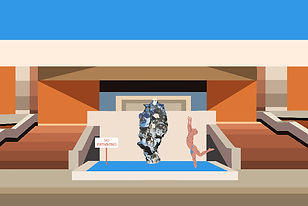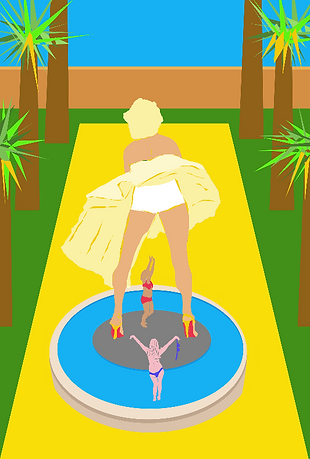Civic Disobedience:
A Quiet Rebellion in Chlorine and Civic Order
By Terry Hastings
What does it mean to swim where you’re not supposed to, sit where you shouldn't, or stage a pirouette on the steps of a bank? In Civic Disobedience, that act is less about confrontation and more about invitation—asking the viewer to pause, squint, and realize that something’s a little off. A little off, and therefore, possibly more true.
This series began not with a manifesto, but a misstep—deliberate or otherwise.
Cactus Garden – Sunnylands
The origin story. A single figure swims through what’s supposed to be a reflecting pool. Stylized barrel cacti line the garden like sentries, the palette hums in pink, gold, and chlorinated blue. At first glance, it’s just lovely. But peer closer and the act of defiance becomes clear: this isn’t just a garden; it’s a provocation. Cactus Garden quietly disrupts the revered symmetry of Sunnylands with an act as simple as going for a dip. This piece laid the groundwork—both literal and metaphorical—for the rebellion to come. Before the signs went up, the swimmer had already passed through.
No Swimming – Sunnylands
Here, the rules arrive. The “No Swimming” sign looms politely. The symmetry is undisturbed, but the defiance continues. A figure now walks across the mirror pool in full daylight, daring civility to flinch. This isn’t vandalism. It’s visual side-eye. A “what if” encoded in architectural reverence. The commentary deepens: how much is this place about reflection, and how much about restriction? The desert, once a space of freedom, is now a curated corridor. And yet—this figure walks anyway.
No Swimming – Art Museum
From a presidential estate to the city’s cultural core. The Palm Springs Art Museum, all brutalist gravitas and sanctioned intellect, now finds itself serving as a backdrop for a poolside lounge. The figure is stretched out, statuesque in leisure, transgressing nothing more than the institution’s invisible codes of decorum. But it’s enough. The museum’s reflecting pool becomes part spa, part spectacle. And in doing so, it raises a simple question: who belongs in this space, and on what terms?
NO SWI… – Aluminaire House
Now the rules start to stutter. The sign is only half visible. The architecture—pristine, cubic, canonical—is untouched. But the implication hangs heavy: the signage wants to speak, but the figure has already arrived. This piece leans into the absurdity of control, of incomplete instructions in complete spaces. Aluminaire, an icon of early modernism, becomes a playground. The rebellion here isn’t loud. It’s clean, crisp, and wholly unbothered. The figure isn’t asking for permission; they’re asking what the architecture was trying to protect in the first place.
Celebrating the Feminine
The gloves come off. A 26-foot-tall Marilyn Monroe statue lands in the middle of a public street, and the town loses its mind. Seward Johnson’s Forever Marilyn doesn’t just provoke—it absorbs every ounce of civic attention for years: lawsuits, debates, public outcry. And through it all, Terry stands off to the side, framing the scene like a documentarian with a razor blade in his lens.
This piece isn’t interested in glamour. It’s interested in process. The way spectacle got smuggled in as public art. The way the museum’s sightlines were blocked. The way nostalgia was weaponized as virtue. The title—Celebrating the Feminine—is half bless-your-heart and half deposition. It asks not whether the statue is offensive, but whether the city ever bothered to ask in the first place. And when she’s finally forced to move? The outrage isn’t over the broken process—but that the spectacle had to stop. Terry doesn’t flinch. He documents. He names it. And he lets the viewer decide what it was they were really celebrating.
Chase Bank (Coachella Valley Savings & Loan)
Now the rebellion has wheels. A skater glides across the pristine plaza of one of Palm Springs’ most iconic mid-century banks—designed by E. Stewart Williams in 1961. The inverted arches hold firm. The corporate facade stands stoic. But the skater? Arms outstretched in a moment of joyous defiance. The figure doesn’t confront the institution—they glide past it, refusing to carry its weight. It’s a ballet of bureaucracy and motion. The space holds history. The figure holds momentum.
Wish You Were Here (aka Mirage)
It all ends in a fantasy. A paper pool. A cardboard palm tree. A billboard of mountains covering the real ones. And a figure, dressed for the dream, staring at the mirage they were promised. Originally titled Mirage as a nod to neighboring Rancho Mirage, the piece pokes at the way desert dreams are sold before they’re built, and how people are convinced to show up anyway. It’s satire in full color—cheeky, wistful, and a little too familiar. The promise was paradise. The reality was printed flat.
Epilogue: Rebellion with a Smile
Civic Disobedience isn’t about chaos. It’s about clarity. Each piece poses a question—not shouted, but suggested. Can leisure be subversive? Can architecture be repurposed through play? Can the act of being—swimming, lounging, skating—be its own kind of protest in spaces designed to say no?
Terry Hastings doesn’t storm the castle. He floats past it on an inflatible alligator. His is a rebellion not of noise, but of nudges. A visual thread that dares to say: what if we didn’t take the rules so seriously? What if the city, in all its curated glory, was seen not just as a destination—but a dialogue?
And maybe, just maybe, that red carpet doesn’t lead to a real pool. But the invitation still stands.
Wish you were here.






